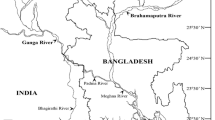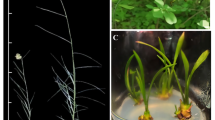Abstract
Ahnfeltia plicata (Hudson) E.M. Fries (Rhodophyta, Ahnfeltiales) is one of the most commercially important agarophytes in the world for its production of agar that is high quality and low in sulfate content. In the Magellanic Region, A. plicata forms extensive beds with high biomass production, which could be commercially exploited for agar production. The purposes of this study were to determine the optimal conditions of temperature, salinity, and culture medium; to evaluate the effects of different types and concentrations of auxins and cytokinins on growth of red and yellow gametophytes; and to provide background information on ecological parameters of natural population of A. plicata. Temperatures of 5, 8, 15, and 23 °C were tested, and the interaction of salinity of 25 and 35 psu with Provasoli enriched medium in half (PES/2) and quarter strength (PES/4), and with von Stosch enriched medium in half (VSES/2) and quarter strength (VSES/4) was also conducted. Concentrations of 5.0 and 50.0 μM of two auxins (indole-3-acetic acid (IAA), 2,4-dichlorophenoxyacetic acid (2,4-D)), and two cytokinins (isopentenyladenine (iP) and benzylaminopurine) were added to VSES medium and gelled with 0.5 % agar. Each treatment was tested with three replicates. Red gametophytes of A. plicata tolerate a range of temperature variation, from 5 to 23 °C, and the optimum temperature for growth was 15 °C. The highest growth rate was observed in salinity of 35 psu with half strength of von Stosch culture medium. Red and yellow gametophytes showed different responses to plant growth regulators, and red gametophytes were more sensitive than yellow ones to the addition of IAA and high concentration of iP. However, growth of red gametophytes of A. plicata was stimulated by 2,4-D. The differential sensitivity of red and yellow gametophytes to plant growth regulators suggests the need to test other types and concentrations of auxins and cytokinins.






Similar content being viewed by others
References
Airoldi L (2003) The effects of sedimentation on rocky coast assemblages. Oceanogr Mar Biol Annu Rev 41:161–236
Avila M, Hoffmann AJ, Santelices B (1985) Interacciones de temperatura, densidad de flujo fotónico y fotoperíodo sobre el desarrollo de etapas microscópicas de Lessonia nigrescens (Phaeophyta, Laminariales). Rev Chil Hist Nat 58:71–82
Breeman AM (1988) Relative importance of temperature and other factors in determining geographic boundaries of seaweeds: experimental and phenological evidence. Helgolander Meeresunters 42:199–241
Chapman VJ, Chapman DJ (1980) Seaweeds and their uses, 3rd edn. Chapman and Hall, London, p 334
Cherbadgy II, Popova LI (1998) Distribution, biomass and primary production of an Ahnfeltia tobuchiensis (Ahnfeltiales, Rhodophyta) population in the Bay of Izmena, Kunashir Island. Phycol Res 46:1–10
Costa VL, Plastino EM (2001) Histórico de vida de espécimes selvagens e variantes cromáticas de Gracilaria birdiae (Gracilariales, Rhodophyta). Rev Bras Bot 24:491–500
Davies PJ (1995) The plant hormone concept: concentration, sensitivity and transport. In: Davies PJ (ed) Plant hormones—physiology, biochemistry and molecular biology. Kluwer, Dordrecht, pp 13–38
Davies AN, Wilce RT (1987) Floristics, phenology, and ecology of the sublittoral marine algae in an unstable cobble habitat (Plum Cove, Cape Ann, Massachusetts, USA). Phycologia 26:23–34
Fries L (1966) Temperature optima of some red algae in axenic culture. Bot Mar 9:12–14
Guimarães M, Plastino EM, Destombe C (2003) Green mutant frequency in natural populations of Gracilaria domingensis (Gracilariales, Rhodophyta) from Brazil. Eur J Phycol 38:165–169
Hehre EJ, Mathieso AC (1970) Investigations of New England marine algae III composition, seasonal occurrence and reproductive periodicity of the marine Rhodophyceae in New Hampshire. Rhodora 72:194–239
Kaliaperumal N, Chennubhotla VS, Kalimuthu S, Ramalingam JR, Muniyandi K (1993) Growth of Gracilaria edulis in relation to environmental factors in field cultivation. Seaweed Res Utiliz 16:167–176
Krikorian AD (1995) Hormones in tissue culture and micropropagation. In: Davies PJ (ed) Plant hormones—physiology, biochemistry and molecular biology. Kluwer, Dordrecht, pp 774–796
Kursar TA, van der Meer J, Alberte RS (1983a) Light-harvesting system of the red alga Gracilaria tikvahiae I. Biochemical analyses of pigment mutations. Plant Physiol 73:353–360
Kursar TA, van der Meer J, Alberte RS (1983b) Light-harvesting system of the red alga Gracilaria tikvahiae II. Phycobilisome characteristics of pigment mutants. Plant Physiol 73:361–369
Kylian R, Baeza O, Steinke T, Arevalo M, Rios C, Schneider C (2007) Late Pleistocene to Holocene marine transgression and thermohaline control on sediment transport in the western Magellanes fjord system of Chile (53S). Quatern Int 161:90–107
Lüning K (1984) Temperature tolerance and biogeography of seaweeds: the marine algal flora of Helgoland (North Sea) as an example. Helgolander Meeresunters 38:305–317
Lüning K, Freshwater W (1988) Temperature tolerance of northeast Pacific marine algae. J Phycol 24:310–315
Maggs CA, Pueschel CM (1989) Morphology and development of Ahnfeltia plicata (Rhodophyta): proposal of Ahnfeltiales ord. nov. J Phycol 25:333–351
Maggs CA, McLachlan JL, Saunders GW (1989) Infrageneric taxonomy of Ahnfeltia (Ahnfeltiales, Rhodophyta). J Phycol 25:351–368
Mansilla A, Navarro N (2003) Contribución al estudio de la flora ficológica de las islas Diego Ramírez (Chile). In: Werlinger C, Navarro N (eds) Mansilla A. Memorias Curso Internacional de Postgrado y Especialización de Macroalgas en Ambientes Subantárticos Ediciones Universidad de Magallanes, Punta Arenas, pp 85–89
Mansilla A, Palacios M, Aguilar S (2004) Efecto de la salinidad en el desarrollo en Sarcothalia crispata (Bory) Leister bajo condiciones de laboratorio. Ann Inst Patagonia Serie Cs Nat 32:13–33
Martins AP, Yokoya NS, Carvalho MAM, Plastino EM (2008) Effects of kinetin and nitrogen on growth rates, pigment and protein contents in wild and phycoerythrin-deficient strains of Hypnea musciformis (Rhodophyta). J Appl Phycol 20:767–773
Milstein D, Saunders GW (2012) DNA barcoding of Canadian Ahnfeltiales (Rhodophyta) reveals a new species—Ahnfeltia borealis sp. nov. Phycologia 51:247–259
Müller DG, Lüthe NM (1981) Hormonal interaction in sexual reproduction of Desmarestia aculeata (Phaeophyceae). Brit Phycol J 16:351–356
Müller DG, Meel H (1982) Culture studies on the life history of Arthrocladia villosa (Desmarestiales, Phaeophyceae). Brit Phycol J 17:419–425
Munda IM, Liining K (1977) Growth performance of Alaria esculenta off Helgoland. Helgolander Wiss Meeresunters 29:311–314
Niwa K, Mizuta A, Aruga Y (2002) Genetic characterization of a spontaneous green–type pigmentation mutant of Porphyra yezoensis and the significance of using heterozygous conchocelis in nori farming. Fish Sci 68:729–735
Oliveira EC, Paula EJ, Plastino EM, Petti R (1995) Metodologias para cultivo no axenico de macroalgas marinhas in vitro. In: Alveal K, Ferrario ME, Oliveira EC, Sar E (eds) Manual de Métodos Ficológicos. Universidad de Concepción, Concepcion, pp 429–447
Ortiz FA (2011) Caracterización estacional, determinación estructural y modificación química de los polisacáridos solubles de Ahnfeltia plicata. PhD thesis, Universidad de Santiago de Chile, p 52
Pavlyuk O, Trebukhova Y, Thanh NV, Tu ND (2008) Meiobenthos in estuary part of Ha Long Bay (Gulf of Tonkin, South China Sea, Vietnam). Ocean Sci J 43:153–160
Ramlov F, de Souza J, Farias A, Maraschin M, Horta PA, Yokoya NS (2012) Effects of temperature, salinity, irradiance, and nutrients on the development of carposporelings and tetrasporophytes in Gracilaria domingensis (Kütz.) Sonder ex Dickie (Rhodophyta, Gracilariales). Bot Mar 55:253–259
Ramus J, Meer JP (1983) A physiological test of the theory of complementary chromatic adaptation. I. color mutants of a red seaweed. J Phycol 19:86–91
Santelices B, Marquet P (1998) Seaweeds, latitudinal diversity patterns, and Rapoport's rule. Divers Distrib 4:71–75
Skriptsova AV, Nabivailo YV (2009) Comparison of three gracilarioids: growth rate, agar content and quality. J Appl Phycol 21:443–450
Stolpe U, Wiencke C, Clayton M, Lehmann H (1991) Life history, morphology and development of a Desmarestia ligulate species from southernmost Chile. Brit Phycol J 26:235–245
Sukhoverkhov SV, Kadnikova IA, Podkorytova AV (2000) Production of agar and agarose from the red alga Ahnfeltia tobuchiensis. Appl Biochem Micro 36:201–203
Sundene O (1962) The implications of transplant and culture experiments on the growth and distribution of Alaria esculenta. Nytt Mag Bot 9:155–174
van den Hoek C (1982a) The distribution of benthic marine algae in relation to the temperature regulation of their life histories. Biol J Linn Soc 18:81–144
van den Hoek C (1982b) Phytogeographic distribution groups of benthic marine algae in the North Atlantic Ocean. Helgolander Meeresunters 35:153–214
Wiencke C, Clayton MN (2002) Antarctic seaweeds. Synopses of the Antarctic benthos, vol 9. P 239. A.R.G. Gantner Verlag KG, Ruggell
Wiencke C, Dieck IT (1990) Temperature requirements for growth and survival of macroalgae from Antarctica and southern Chile. Mar Ecol Prog Ser 59:157–170
Yokoya NS (2000) Apical callus formation and plant regeneration controlled by plant growth regulators in axenic culture of the red alga Gracilariopsis tenuifrons (Gracilariales, Rhodophyta). Phycol Res 48:133–142
Yokoya NS, Kakita H, Obika H, Kitamura T (1999) Effects of environmental factors and plant growth regulators on growth of the red alga Gracilaria vermiculophylla from Shikoku Islands, Japan. Hydrobiologia 398/399:339–347
Yokoya NS, Plastino EM, Artel R (2003) Physiological responses and pigment characterization of two colour strains of the carrageenophyte Hypnea musciformis (Rhodophyta). In: Chapman, ARO, Anderson RJ, Vreeland VJ, Davison IR (eds) Proceedings of the 17th International Seaweed Symposium, Oxford University Press, New York, pp 425–433
Yokoya NS, Necchi Júnior O, Martins AP, Gonzalez SF, Plastino EM (2007) Growth responses and photosynthetic characteristics of wild and phycoerythrin-deficient strains of Hypnea musciformis (Rhodophyta). J Appl Phycol 19:197–205
Zar JH (1999) Biostatistical analysis. Prentice Hall, Upper Saddle River, p 663
Zhang XC, Van Der Meer JP (1987) A study on heterosis in diploid gametophytes of the marine red alga Gracilaria tikvahiae. Bot Mar 30:309–314
Acknowledgments
The authors thank the support from FONDEF and CONICYT, Chile (Project DO8I1163 to AM and Project MEC 80100021 to NSY). Research fellowship from CNPq (Brazil) to NSY is also acknowledged. Dr. T. Contador, E. Velasquez, and Kelly Moses (University of North Texas, USA) were acknowledge for translation and revision of the English manuscript. S. Rosenfeld would like to thank the scholarship provided by the Institute of Ecology and Biodiversity (Chile) (code ICM P05-002) and the Master of Science in Conservations and Management of Sub-Antarctic Ecosystem of the University of Magallanes.
Author information
Authors and Affiliations
Corresponding author
Rights and permissions
About this article
Cite this article
Mansilla, A., Rodriguez, J.P., Souza, J.M.C. et al. Growth responses to temperature, salinity and nutrient variations, and biomass variation and phenology of Ahnfeltia plicata (Rhodophyta, Ahnfeltiales): a commercially interesting agarophyte from the Magellanic Region, Chile. J Appl Phycol 26, 1133–1139 (2014). https://doi.org/10.1007/s10811-013-0150-0
Received:
Revised:
Accepted:
Published:
Issue Date:
DOI: https://doi.org/10.1007/s10811-013-0150-0




